
Face it: GM Gen III/IV small-blocks, Ford Modular motors, and new Chrysler Hemis have rejuvenated production cars, and now they're poised to revolutionize hot-rodding.
Overhead cams, forced induction, aluminum heads, and even aluminum blocks are no longer exotic rarities. Engine life is now measured in hundreds of thousands of miles. Fast-burn combustion chambers and heads that flow on a par with old-school big-blocks offer growth potential old-school small-block owners could only dream of. Combine the new engine designs with an overdrive trans, and you can have your cake and eat it too-economical highway cruising with big horsepower. A whole new industry has arisen for hopping them up, supplying them, and even installing them in classic musclecars-that bundle of snakes under the hood notwithstanding. No doubt, traditionalists shy away from the high-tech marvels because of their seeming technical complexity. And while the electronic component of a modern swap is at least as complex as the physical aspect, aftermarket solutions are appearing almost daily.
Many rodders prefer to swap in the late-model engine along with its corresponding electronic trans, which interfaces correctly with the factory computer and eliminates adapter issues, but it's also possible to bolt up classic transmissions using available aftermarket parts. Remember that any high-pressure EFI retrofit requires EFI-compatible fuel-tank baffling, fuel lines, and fuel-pump configuration (Rock Valley is one source for retrofit fuel tanks).
The Ford and GM engines have been available for more than 10 years; even the new Hemi is now five years old. Standard-perf versions of these engines are fairly common and affordable in the wrecking yards. If you have your heart set on a high-perf mill and can't find one through the usual sources, Linda Quest at Engine Town has nationwide contacts for all makes and models and swears she can come up with virtually any complete takeout your heart desires (but have your wallet ready). There's also the factory crate-motor route.
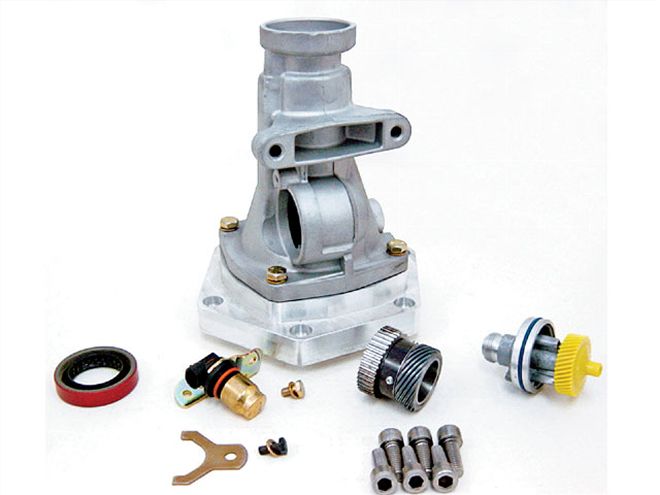 This production version of the DVS SN-95 swap kit installs a '94-'05 Mustang frontend in a '65-'70 Mustang/Cougar. (Modified Fox-body frontends work, too). The late K-member offsets the motor toward the passenger side 2 inches allowing the supercharged Cobra motor's alternator to fit without frame notching. Welding is required.
This production version of the DVS SN-95 swap kit installs a '94-'05 Mustang frontend in a '65-'70 Mustang/Cougar. (Modified Fox-body frontends work, too). The late K-member offsets the motor toward the passenger side 2 inches allowing the supercharged Cobra motor's alternator to fit without frame notching. Welding is required.
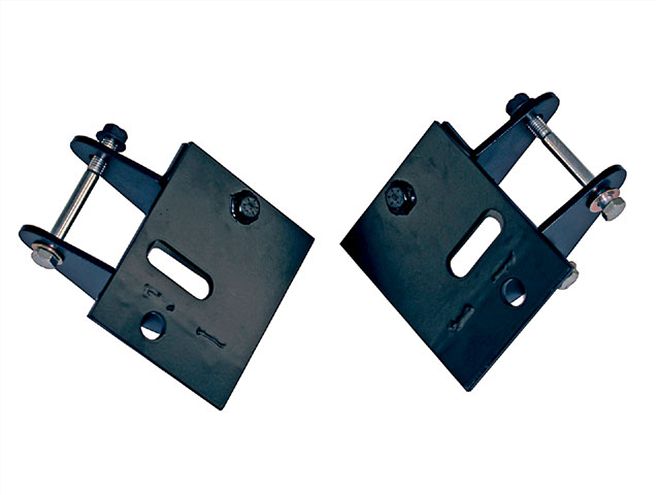 DVS dedicated mounts bolt Mod motors into '67-'70 Mustangs/Cougars with stock suspensions using late SN-95 Mustang insulators. The mounts are available individually or as part of a master kit that includes a front-sump oil pan and pickup, a trans crossmember, a remote filter mount, and other needed parts.
DVS dedicated mounts bolt Mod motors into '67-'70 Mustangs/Cougars with stock suspensions using late SN-95 Mustang insulators. The mounts are available individually or as part of a master kit that includes a front-sump oil pan and pickup, a trans crossmember, a remote filter mount, and other needed parts.
On the following pages, we examine some of the parts and pieces available to simplify swapping new motors into old cars. Hopefully, this overview will whet your appetite for a full-course modernization program on your own ride.
Ford Modular V-8
Ford's Modular motor debuted as a 4.6L two-valve (2V) single overhead cam (SOHC) motor in the '91 Lincoln Town Car. Mustangs got Mod'd in '96. Subsequently, hotter four-valve (4V) dual overhead cam (DOHC) and three-valve (3V) SOHC versions have proliferated. While all the heads have been aluminum, 2V and 3V SOHC motors use iron blocks. DOHC 4V motors have mostly used aluminum blocks; '03-'04 390hp supercharged Mustang Cobras went to a stronger iron block. Ford Racing offers 300hp 4.6L 3V crate motors (PN M-6007-3V46) and a special 400hp 5.0L 4V (PN M-6007-T50EA).
Trucks got the high-deck 5.4 starting in '97. Most are 2V SOHC engines (including the supercharged F-150 Lightning), but 4V 5.4s appeared in the '00 Cobra R, Ford GT, and '07 Shelby Mustang GT500. The 5.4s in Ford GTs came with a Lysholm screw supercharger and dry-sump oiling, developing an astounding 550 hp and 500 lb-ft (crate motor PN M-6007-GT).
The '99-and-later engines have returnless fuel systems. Instead of a pressure regulator and a return line, the stock computer changes the fuel pressure (and hence fuel flow and volume) by varying the fuel-pump voltage as needed. DVS Restorations modifies old tanks for the '03 Cobra in-tank fuel pump and returnless fuel system.
All Mod motors are neutral balanced. The Mod motor's rear-block-face bolt pattern and engine mounts are unique, but the mount pads are located in the same relative location in relation to the bellhousing face as a classic Ford small-block. Mounting-solution parts as well as in-house swap services and custom tuning are available from DVS Restorations, Superior Custom Classics, AEW, Paul's High Performance, and others. Car motors are more compact and their motor mounts better adapt to retrofit installations. "Mustangs have the best exhaust manifolds and the most adaptable mounts," maintains AEW's Mark Sanchez.
But any way you slice it, the overhead cam Mod motors are wide. They have clearance problems with classic Ford musclecars' high-mounted shock towers. It's even worse on the 5.4s due to their higher decks. The 2V 5.4s are at least 1 inch taller and wider than 2V 4.6s. The 4V DOHCs are about 4 inches wider, more massive than even a 427-SOHC big-block. It's possible to retain the stock '67-'70 Mustang frontend by dimpling the shock towers for a 2V or notching them for a 4V. The '65-'66 models mount the front upper control arms 1 inch more inboard per side than the '67-'70 chassis, requiring a more radical approach. RRS offers a MacPherson-strut conversion and shock-tower cut-back plates that eliminate the upper arms and provide needed clearance while retaining the stock steering linkage.
But the most sanitary solution is to upgrade the whole frontend to MacPherson struts plus a rack-and-pinion (R&P) steering setup. This approach works on the '67-'70 cars as well, providing a lighter, roomier, and more modern frontend. Conversion kits are offered by DVS, Heidt's, Rod & Custom Motorsports, Griggs Racing, Fat Man Fabrication, and others. The DVS kits retain all the original late-model Ford suspension geometry, permitting vintage Mustang owners to install a full suite of aftermarket Steeda or Maximum Motorsports late-model suspension enhancers. Interestingly, the late-model SN-95 Mustang radiator does fit between classic Mustang framerails-and the 4.6 radiator allows running the Ford-controlled electric fan.
Dropping the Mod motor into a '79-and-later Fox-bodied Mustang is lots easier than a classic musclecar retrofit, Sanchez says. Just adapt the '96-'04 SN-95 Mustang Modular motor crossmember or use an aftermarket tubular conversion 'member. Maximum Motorsports' version has two sets of slots so it can take either the classic small-block or the Mod motor. Depending on the specific chassis year, some front-suspension mods may also be required. For clearance, you will need to go to the '96-'04 Mustang SN-95 Hydroboost power-brake assist in place of the existing vacuum booster or revert to manual brakes. Use 2V or 4V factory Mustang headers or MAC headers.
Most Mod motor ECMs have sophisticated, hard-to-defeat antitheft systems. Superchips Custom Tuning (SCT) offers sophisticated (albeit pricey) tuning solutions for the stock computer. Ford Racing should offer a retrofit wiring harness by this summer. S&P and Painless Wiring also sell harnesses now. Some '96 computers did not have antitheft provisions. Pre-'96 computers used undesirable EEC-4 electronics, which should be avoided. The custom wiring, retrofit, and computer reprogramming specialist Haywood Custom Speed says '99-'04 processors are better and quicker, but the '05-and-later drive-by-wire (DBW) computers are more likely to throw codes. DBW throttle bodies require the donor car's throttle pedal. Retrofitting a cable-actuated throttle body to a DBW intake requires an adapter plate, since Ford changed the mounting bolt pattern. However, Accufab is working on a billet cable-actuated throttle body with the DBW bolt pattern. Hopped-up motors may require larger fuel injectors. If so, you must either recalibrate the stock mass airflow (MAF) meter or install an aftermarket MAF.
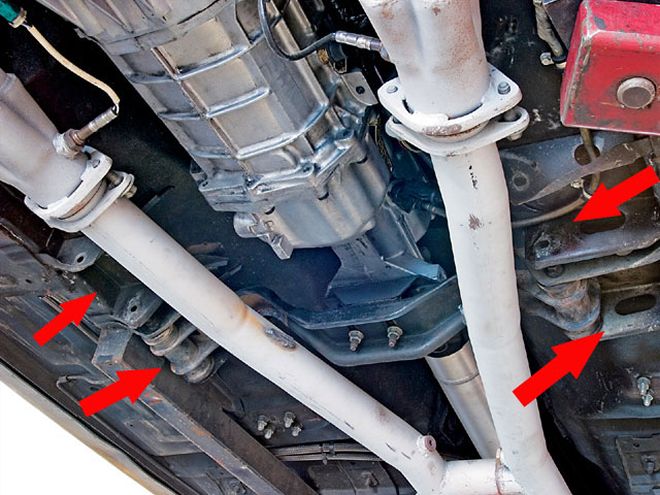 There's not enough slack in Ford Racing's adjustable crossmember to accommodate a T45 or T56 behind a Mod motor in a Fox-body. Move the stock trans support 611/42 inches back from the existing mount centerline. AEW says to install new Ford trans-support frame brackets in the proper position or get '97-'98 brackets. Use the stock T5 trans mount.
There's not enough slack in Ford Racing's adjustable crossmember to accommodate a T45 or T56 behind a Mod motor in a Fox-body. Move the stock trans support 611/42 inches back from the existing mount centerline. AEW says to install new Ford trans-support frame brackets in the proper position or get '97-'98 brackets. Use the stock T5 trans mount.
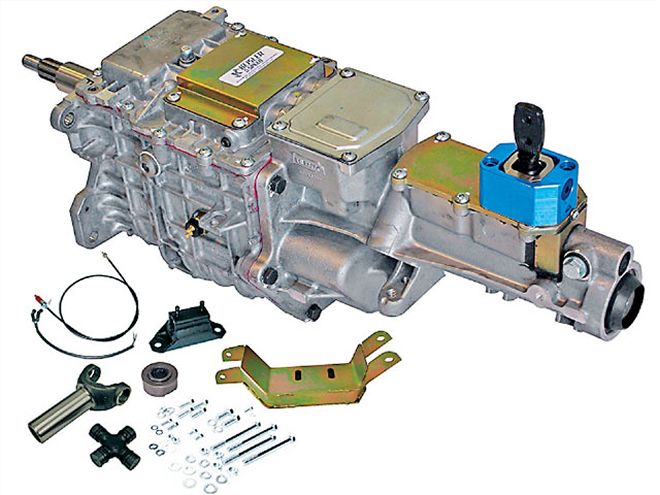 Keisler's TKO swap kits for '65-'70 Mustangs let you upgrade from a classic four-speed or convert from an automatic. They include a new trans plus all necessary parts, including, as needed, a new crossmember, hydraulic clutch linkage, a yoke, and a bellhousing. The shifter even lines up with the existing floorpan hole.
Keisler's TKO swap kits for '65-'70 Mustangs let you upgrade from a classic four-speed or convert from an automatic. They include a new trans plus all necessary parts, including, as needed, a new crossmember, hydraulic clutch linkage, a yoke, and a bellhousing. The shifter even lines up with the existing floorpan hole.
Some Mod specialists prefer to avoid hassling with the antitheft system, preferring an aftermarket computer. Superior Custom likes ACCEL's Gen 7 system. Owner Rich Brandl says, "It lets us get more out of the motor." Brandl's custom harnesses marry the ACCEL wiring to the factory Ford wiring. The user-friendly harness requires hooking up only four wires to the battery, but you'll need to learn how to use the Gen 7 software.
Mod motors all use coil ignition systems without distributors. The coil packs were in front of the cylinder heads on '98-and-earlier models. Starting in '99, Mod motors went to a coil-on-plug setup that usually makes for a cleaner installation.
Lentech, Performance Automatic, and J.W. offer adapters for bolting up older automatic transmissions to the Mod motor. Baumann has standalone controllers for the late-model automatic transmissions if needed. Use a Tremec bellhousing for a TKO or 3550-series five-speed. D&D Fabrication and McLeod Industries have all sorts of manual-trans adapter solutions. Keisler has a full line of trans swap kits; currently it specs the TKO over the T56 in most instances due to new core availability as well as easier fitment in classic chassis.
GM Gen III/IV Small-Block
GM calls its LS engines small-blocks, but the LS motors and their truck brethren really are all-new designs sharing no parts except the rod bearings with classic small-blocks. First introduced as the 5.7L all-aluminum LS1 in the '97 Vette, the Gen III found a home in the Camaro/Firebird starting in '98. Usage spread into '99 trucks and SUVs with new 4.8L, 5.3L, and 6.0L iron-block variants. In '04, the Gen III configuration gave way to the Gen IV. Revisions include revised casting techniques to produce larger-displacement 6.0L, 6.2L and 7.0L aluminum blocks, as well as provisions to implement displacement-on-demand and variable valve timing. The 7.0L (427.6 ci) LS7 is exclusive to the Corvette and is rated at 505 hp and 470 lb-ft. Exotic LS7 components include titanium valves and connecting rods, as well as a dry-sump oiling system. Crate LS1 (PN 25534322), LS2 (PN 19156261), and LS7 (PN 17802397) engines are available through GM Performance Parts (GMPP). The new '07 Escalade all-aluminum L92 6.2L (403 hp with variable valve timing) will be offered as a crate motor under PN 19165485. GMPP also sells an LSX iron block (PN 19166454). Rated to withstand 2,500 hp, it can be built as large as 511 ci (4.25 bore x 4.5 stroke).
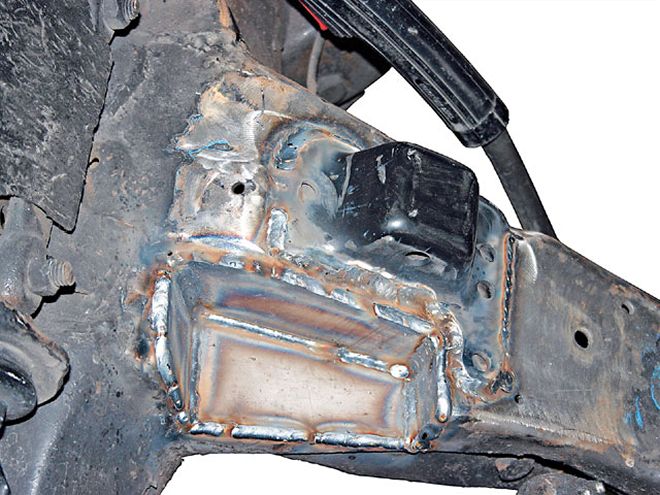 With stock Camaro LS accessories, the low-mounted factory A/C compressor often hits classic front K-members, as on this early A-body. Brewer's made a 6-inch-long x 3-inch-wide x 311/42-inch-deep cut then welded in a section of 11/48-inch-thick steel plate. Brewer's has complete installation kits with detailed instructions for most classic GM chassis.
With stock Camaro LS accessories, the low-mounted factory A/C compressor often hits classic front K-members, as on this early A-body. Brewer's made a 6-inch-long x 3-inch-wide x 311/42-inch-deep cut then welded in a section of 11/48-inch-thick steel plate. Brewer's has complete installation kits with detailed instructions for most classic GM chassis.
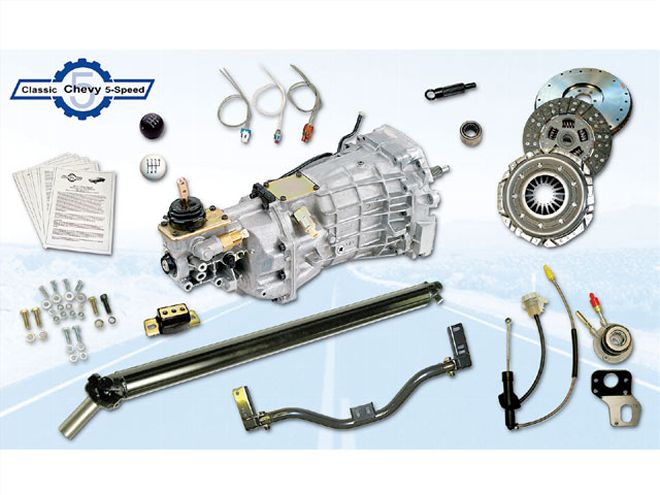 Classic Chevy's bread-and-butter are complete T56 six-speed and TKO five-speed installation kits for classic GM chassis. Everything needed for the installation is provided, including (as necessary) a new driveshaft, a trans crossmember, a trans mount, hydraulic clutch conversion parts, a clutch assembly, a shifter, instructions, and the trans itself.
Classic Chevy's bread-and-butter are complete T56 six-speed and TKO five-speed installation kits for classic GM chassis. Everything needed for the installation is provided, including (as necessary) a new driveshaft, a trans crossmember, a trans mount, hydraulic clutch conversion parts, a clutch assembly, a shifter, instructions, and the trans itself.
Gen III/IV motors are physically similar except for different harmonic balancers, water-pump offsets, oil-pan configurations, and rear crank offsets. Gen IV front covers and front dress are different from Gen III parts. One big change was to the crank-mounted ignition reluctor ring. First implemented on '06 Corvettes before being rolled into other chassis starting in '07, the original 24-tooth reluctor ring was replaced by a 58-tooth ring. At this time, there was also a change in the cam sensor and cam sprocket. The engine-control module (ECM) must be compatible with the new sensors (look for E38 or E67 cast into the ECM cover). The E38/E67 ECM no longer incorporates control functions for the electronically controlled auto trans (including the 4L60E, 4L65E, 4L70E, 4L80E, and new six-speed automatics), which must use GM's new standalone production TCM. Alternatively, GMPP and TCI market standalone computers for controlling the late-model electronic automatics.
Why not revert to an earlier ECM? That requires removing the crank to change reluctor rings as well as the new cam sensor and sprocket. For identification purposes, the external electrical connector to the reluctor ring is located near the starter on the passenger side. A 24-tooth reluctor-ring connector is black; a 58-tooth ring is gray. There are also MAF differences. The computer should match the MAF, reluctor/ cam sensor, and (ideally) trans. Implementing displacement-on-demand also requires those models' separate body computer in addition to the ECM and TCM. Computer reprogramming is needed to bypass the vehicle antitheft system (VATS) used on many models.
Rear-sump F-body and truck oil pans are the most adaptable and fit many classic chassis. The Cadillac CTS-V pan's sump kick-down is about 1 inch farther back than the Camaro's. GTOs have a front-sump pan, which could be a good match for early Chevy IIs. Due to their side kick-out wings, '97-'04 Corvette wet-sump pans are hard to adapt to anything except other Vettes. The '05-'07 LS2 Vette pan did away with the wings and works well in low-ground-clearance street rods. The LS7 dry-sump Vette pan won't fit most classic chassis, either-yet modifying it is hard because oil-feed passages are incorporated into the pan. Replacing it with a wet-sump pan requires a Don Hardy spacer (because the LS7 crank is longer) and an LS2-style front cover. Canton offers custom oil-pan sumps on a special-order basis; it and Dailey Engineering also offer dry-sumps. But the easiest overall options are the new LS pans available from both Milodon and Moroso.
The Gen III/IV bellhousing bolt pattern is similar to the classic Chevy V-8 except for one bolt (it adds one new hole and deletes an existing hole). You can bolt up a classic auto-trans or manual-trans bellhousing using metric bolts, leaving one bolt hole unused. On most engines, the crank rear offset from the block is 0.400 inch less than a classic Chevy V-8. GM offers a special pilot bearing (PN 12557583) that compensates for the offset difference and allows the use of a standard-length classic manual-trans input shaft. Another alternative is dedicated installation kits available from Keisler or Classic Chevy 5-Speed, as well as McLeod's modular bellhousing system. McLeod also has a trick shifter setup for late-model, internal-rail manual trannies that allows significant stick position alterations so the handle comes out the right place in the console.
For a classic automatic, use flexplate GM PN 12551367 plus spacer PN 12563532. TCI also offers an auto-trans flexplate that allows bolting up classic GM automatics to Gen III/IV engines. In some cases, when using an early torque converter with a GM factory flexplate, the converter mounting holes must be elongated.
GMPP publishes an excellent manual for Gen III engines (PN 88959384) that describes which factory parts are available to facilitate retrofits (it hasn't yet been updated to cover Gen IV engines). Street & Performance (S&P) offers a frequently updated 211/42-hour instructional DVD on how to swap these engines. Both S&P and Trans-Dapt Performance sell universal engine-mount brackets that adapt the LS-style block engine-mounting bolt pattern to classic Chevy V-8 mounting systems. In fact, S&P is also your one-stop source for all sorts of universal problem solvers including oil pans, fuel-system parts, computer reprogramming, wiring harnesses and wiring parts, complete crate engines, numerous parts for getting the late-style electronics to work right with earlier nonelectronic transmissions, and custom pulley-drive setups (including relocation solutions for the typical factory low-mount A/C compressor that may hit early crossmembers). If desired, S&P can convert the returnless fuel rails used on most of these engines to a return-type system.
Brewer's Restoration and Performance (BRP) offers complete engine and trans swap kits for most X-bodies (Chevy II/Nova and clones), all A/G-bodies (Chevelle, Monte Carlo, and clones), and '67-'81 Gen 1 and 2 F-bodies (Camaro/Firebird). On Gen 1 F-cars, the existing front-clip/rear-steer setup can be retained, if desired, by modifying a stock Camaro Gen III engine oil pan or by using available GMCOPO or S&P pans. Brewer's Camaro conversion parts are also available through Year One. Future Brewer kit plans include early Vettes, B-bodies (fullsize passenger cars), and trucks.
Turn Key Engine Supply sells fully dressed and hopped-up engines plus the parts to install them in the specific chassis. Currently, retro swap kits for the '62-'67 Nova, '55-'57 Chevy, '67-'69 Camaro, and '66-'72 Chevelle are available. Included are long-tube headers, small-block motor-mount adapters, and a modified oil pan.
 Starting in '96, GM 4L60E transmissions began moving to six-bolt extension housings in place of the previous four-bolt housings. All factory six-bolt housings are set up for electrically driven speedos. S&P offers a special six-bolt 4L60E/4L65E housing kit that accepts mechanical speedo cables and gears. The mount pad lines up with TH200-4R/TH400 mounts.
Starting in '96, GM 4L60E transmissions began moving to six-bolt extension housings in place of the previous four-bolt housings. All factory six-bolt housings are set up for electrically driven speedos. S&P offers a special six-bolt 4L60E/4L65E housing kit that accepts mechanical speedo cables and gears. The mount pad lines up with TH200-4R/TH400 mounts.
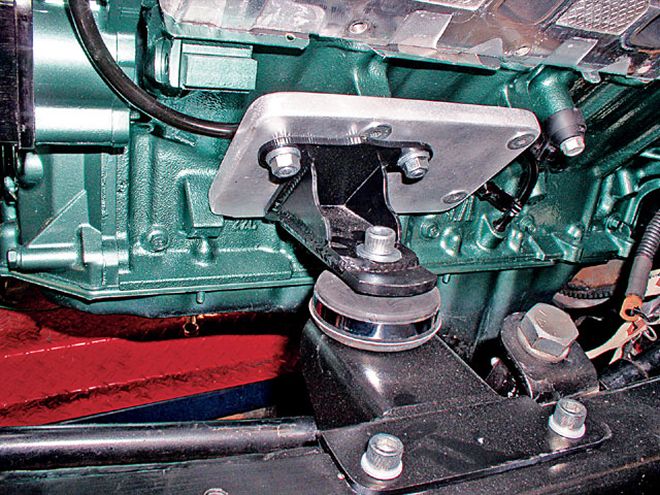 Many street-rod kits come set up for biscuit-style mounts then use steel adapter plates to bolt to the block. Chevy V-8 adapters for this system are widely available. S&P offers an adapter-plate kit that bolts to the Hemi block and in turn picks up a Chevy-style adapter. Frame adapters are also included.
Many street-rod kits come set up for biscuit-style mounts then use steel adapter plates to bolt to the block. Chevy V-8 adapters for this system are widely available. S&P offers an adapter-plate kit that bolts to the Hemi block and in turn picks up a Chevy-style adapter. Frame adapters are also included.
S&P has mounts and headers for '55-'57 passenger cars as well as later Impalas and Caprices. Art Morrison can sell you a complete rolling '58-'62 Vette or Tri-5 Chevy chassis with late Vette suspension that's setup for Gen III/IV engines. Hawks Third Gen offers complete conversion solutions for the '82-'92 F-body. A Hawks kit for '68-'82 Vettes is in the pipeline. To put an LS engine into a '93-'97 fourth-gen F-car, use a '98-'02 F-car front crossmember along with other available parts from Hawks.
GMPP is introducing computer and wiring harness kits that include a DBW pedal. For a 58-tooth-reluctor LS2, order PN 19166568; for an LS7, it's 19166567. Many aftermarket specialists deal in wiring harnesses and computer solutions that allow retention of factory computers. In addition to S&P, these outfits include Dr. K, Howell Engine Developments, Lingenfelter, Painless Performance, Ron Francis, Speartech, GMCOPO, TPIS, and TTS. Lingenfelter and TPIS offer custom engine-building services. Want to home-program a factory computer using a laptop? Check out Carputing's LS1-edit software or VCM's HP Tuner. Complete aftermarket computer systems are available from ACCEL, Electromotive, Holley, FAST, MoTeC, and others.
For traditionalists who like the Gen III engine's modern styling but hate computers, GMPP and Edelbrock have Holley carb-flanged intakes, while Wegner sells a new front cover with a conventional ignition distributor hole that accepts a 351W Ford distributor. The cover uses a standard-rotation Ford water pump.
CHRYSLER 5.7/6.1 HEMI
Chrysler's Hemi is back but in a whole new high-tech incarnation that shares nothing but the name with old-school Hemis. The new Hemi rolled out as a 5.7L motor in '02 Dodge Ram 2500 and 3500 pickups. In '03, usage spread to Dodge Ram 1500s as well as the Chrysler 300C, Dodge Magnum, and Jeep Grand Cherokee. In '05, the 6.1L version appeared in selected SRT vehicles including the Chrysler 300 and Dodge Magnum. By '06, 6.1s could be found in the Dodge Charger and Jeep Grand Cherokee. The 6.1s are rated as high as 425 hp and 420 lb-ft. Some cars have a multidisplacement system (MDS) that can shut off half the cylinders under light load to improve fuel economy. Mopar Performance is introducing a 6.4L crate motor (540 hp carbureted, PN P5153604; 525 hp with EFI, PN P5153605).
Hard-core Mopar guys are already slamming new Hemis into old musclecars. Tube Technologies (TTI), a longtime Mopar exhaust-header specialist, is leading the way with headers, engine mounts, and other needed swap accessories. As TTI owner Sam Davis put it, "Naturally we wanted to have headers for the new Hemi, but to make sure they work, we decided to offer the mounts, too, so everything lines up." TTI mounts are available for classic A-bodies (Dart/Valiant and variants), B-bodies (Belvedere/Coronet), and E-bodies (Challenger/Barracuda). Made exclusively for TTI by Schumacher (which at present does not itself sell the new Hemi mounts directly to the public), the mounts work with typical V-8 K-members (except old 426 Hemi K-members) and the stock-style Chrysler small-block rubber insulators (which you can buy from Schumacher). Polyurethane biscuits are in the pipeline. Another alternative is to replace the entire stock frontend with a Reilly MotorSports new tubular K-member setup for the Hemi. It includes a coilover suspension and rack-and-pinion steering with additional options like air suspension available.
The new Hemi's rear-block-face bolt pattern is similar to a classic Chrysler LA small-block (which is different from the B/RB big-block, 426 Hemi, or Slant Six). Old-school LA-engine automatics and manual-trans bellhousings bolt up (just leave out the top bolt). There is a slight 0.060-inch flexplate ring-gear misalignment due to the Hemi's slightly longer crankshaft offset. In theory, spacers/adapters are needed to make up the difference, but early installers (unaware of the difference) have reportedly just bolted everything up. The new Hemi has an eight-bolt crank flange, so old A-engine flexplates and flywheels can't be used. Mopar Performance is said to be developing a special flexplate for retrofit applications. In the meantime, you could use a stock eight-bolt 426 Hemi flexplate with a classic-style small-block neutral-balance torque converter by elongating one hole in the flexplate.
If you're using an original automatic and TTI mounts, you should not have to relocate the original automatic-trans crossmember. You will, however, have to fabricate kick-down linkage to the throttle body to ensure proper operation. Mopar Performance has parts to facilitate this.
Some swaps have used a Chrysler A-518 four-speed automatic overdrive. Although it's the same length as an A-727, the A-518 is a lot fatter. The mount pattern is the same as a GM trans, and a GM TH350 mount is recommended. One advantage of this beefy A-727 descendent is that it does not require a computer or lockup converter, and Overdrive can be actuated with a simple toggle switch. On the other hand, the bulky trans requires major floorpan surgery. Even bulkier is the stock late-model 45RFE electronically shifted trans. It needs its own separate trans controller in addition to the stock engine ECM. A possible alternative is Keisler's new Chrysler overdrive trans conversion kit, which uses a more compact GM 4L65E four-speed automatic with an aftermarket standalone trans-controller.
At present, there are no production Hemi manual-trans applications; however, Chrysler does offer a Viper V-10 manual trans T56 bellhousing which could be adapted. There is also the McLeod modular bellhousing system. Hydraulic clutch or mechanical linkage Z-bar mods are needed plus a custom aftermarket manual trans flywheel. Mopar Performance will soon have new Hemi flywheels and clutch parts.
ECM interface is a problem. Stock Mopar computers don't tolerate hot-rod mods well, and there are no consumer-friendly reprogramming options for the production computer. Street & Performance offers computer reprogramming, but it needs the VIN from the computer's donor vehicle. Mopar Performance's crate fuel-injected motor comes with its own computer and wiring harness (not production-based). AEM is working on a retrofit plug-and-play, user-reprogrammable computer. Alternatively, install a complete aftermarket EFI system.
Chassis electrical interface on old Chryslers can get tricky. Marginal even back in the '60s, the old dinosaurs routed all electrical power through a dash-mounted amp meter. A late-model 140-amp Hemi alternator will fry that old electrical system for sure. You should convert the amp meter to a voltmeter and use an engine-bay distribution hub rather than route all power through the amp-meter circuit. Safely maintaining the alternator's full 140-amp rating really calls for a six-gauge charging wire. Mopar Performance offers a special pigtail that allows wiring the late alternator to the early voltage regulator (PN P4529794). A P4510598 tach adapter may be needed to convert the signal from the Hemi's coil-ignition system. If your local dealer doesn't care to deal with hot rodders, talk to Matt Dean at Glendora Dodge, a leading Mopar Performance dealer that was involved in one of the first new Hemi A-body swaps.